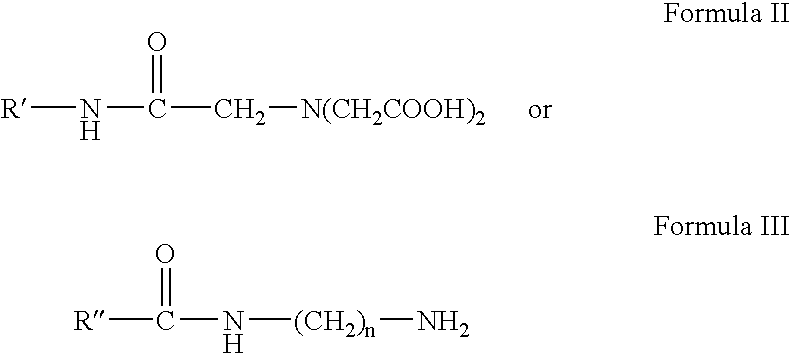Preparing monomeric metal ion chelator containing diacetyl glycine group linked to proteinaceous molecule
- Summary
- Abstract
- Description
- Claims
- Application Information
AI Technical Summary
Benefits of technology
Problems solved by technology
Method used
Image
Examples
example i
This Example Illustrates the preparation of a chelator precursor wherein the molecule, R, containing the amine group is horseradish peroxidase (HRP).
To 48 mg HRP (MW.congruent.40,000), 78.54 .mu.l 0.1 MES, pH 5.5, was added followed by additions of 508 .mu.l nitrilotriacetic acid, trisodium salt solution, pH 9.84, (prepared by dissolving NTA salt to 260 mg / ml in 0.1 M MES, pH 5.5, with no subsequent pH adjustment) and 613.46 .mu.l EDC solution (prepared by dissolving EDC to 150 mg / ml in 0.1 M MES, pH 5.5 with no subsequent pH adjustment). The resulting pH of this reaction mixture was alkaline, approximately pH 9-10.
The solution was allowed to react for 2 hours at room temperature followed by desalting with a Sephadex G-25 column with 0.1 M MES, pH 5.5.
In comparison, the above described condensation reaction was carried out at typical acidic EDC reaction conditions, pH 5-6, by adjusting the reaction mixture pH prior to proceeding with the reaction.
Investigation of molecular differenc...
example ii
This Example illustrates the preparation or iron and nickel activated chelate conjugates using the precursor prepared in Example I.
FeCl.sub.3.6H.sub.2 O or nickel chloride was dissolved in 0.1 MES, pH 5-5.5 and added to the chelate precursor prepared in Example I at an eight fold molar excess based on a molecular weight of HRP of 40,000. Metal was allowed to bind to the precursor for 15 minutes at room temperature and the conjugates so formed subsequently used for probes in detection assays. With the use of an 8 fold molar excess, no further purification was required; equivalent results could be obtained with or without an optional gel filtration step. An eight fold molar excess was considered optimum based on assay performance when various metal loading concentration were tested.
example iii
This Example illustrates the use of the nickel activated conjugate prepared in Example II as a probe for the detection of polyhistidine tagged fusion (PHT) proteins and the comparison of the conjugate so prepared with alternate probes.
Insect Sf9 cells were infected with recombinant baculovirus expressing rat peroxisome proliferator-activated receptor (pA), rat retinoid x receptor (pB) and human thyroid hormone receptor (pC). All proteins were tagged with six consecutive histidine residues. Three days after infection, the cells were harvested, washed once with PBS, and pelleted by centrifugation at 5,000 rpm. The pellets were lysed in 1.times.SDS-PAGE loading buffer at a final concentration of .about.1 mg / ml. After boiling for 5 min, 20 .mu.l of each sample were loaded onto 10% SDS-PAGE gels and simultaneously electrophoresed at 80 V until the dye reached the bottom of the gel. Uninfected Sf9 cells were treated the same as infected cells and used as a negative control. Separated prot...
PUM
| Property | Measurement | Unit |
|---|---|---|
| Composition | aaaaa | aaaaa |
| Alkalinity | aaaaa | aaaaa |
Abstract
Description
Claims
Application Information
 Login to View More
Login to View More - R&D
- Intellectual Property
- Life Sciences
- Materials
- Tech Scout
- Unparalleled Data Quality
- Higher Quality Content
- 60% Fewer Hallucinations
Browse by: Latest US Patents, China's latest patents, Technical Efficacy Thesaurus, Application Domain, Technology Topic, Popular Technical Reports.
© 2025 PatSnap. All rights reserved.Legal|Privacy policy|Modern Slavery Act Transparency Statement|Sitemap|About US| Contact US: help@patsnap.com



